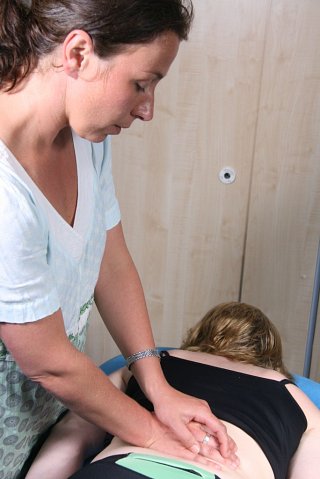Herniated Lumbar Disc

Herniated lumbar discs are a common complaint in my daily work as a chartered physiotherapist. So, let’s have a look at this condition in more detail:
Discs are situated between each vertebra in your spine and the lumbar section of your spine consists of five vertebra that start from below your shoulder blades to your abdomen (see Spine Anatomy). The disc functions as a cushion between each of the bony vertebrae of your back. It needs to be in its correct position to function effectively.
I often describe a disc as being like a jam doughnut. It has a crispy outer shell and a soft jam like centre. A disc herniation may involve the jam in the centre of your disc oozing out to one side or the other. Alternatively, it can involve the outer shell of the disc cracking or moving out of shape in some way. (see What is a Herniated Disc )
Interestingly, the possibility of herniating your lumbar discs tends to reduce as you get older and is more commonly seen in people under the age of 45! This is because the makeup of a disc changes with age, as the water content of the disc lessens. When the water content of the disc lessons so does the mobility of the disc get less.
Symptoms and diagnosing a Herniated Lumbar Disc
If a disc in your lumbar spine herniates, you may experience back pain alone (if the herniation is not impinging on a nerve), or you may have sciatica type pain and symptoms (if a nerve is compressed by the herniated disc). You may also experience Lower back pain, buttock pain. Loss of bladder control can be a symptom of a more serious disc herniation with neurological complications.
The most common area in your spine for herniation of a disc is in the lumbar spine, and the majority of herniations occur at the level of L5/S1, which is low down in your lumbar spine. Herniated discs can occur at other levels also, but less frequently in my practice.
Physiotherapy assessment will often diagnose a herniated disc, and an MRI scans are frequently used to confirm a diagnosis. It is worth noting that although most people will have some disc changes on MRI scanning, these changes are not generally significant unless your symptoms correlate with the MRI findings. In other words, an MRI scan might suggest a deterioration in your spine, but it may not be significant unless you have your symptoms assessed. So, if you have been referred for an MRI by your doctor to investigate a possible herniated disc, it is helpful also to consult a Physiotherapist (Physical Therapist in the U.S) about first understanding the symptoms and treatment options available, particularly if you are considering more extreme options such as surgery.
READ MORE
-
Find out what the typical Symptoms of a Herniated Disc are - and how they are treated
-
Treating a Herniated Disc is very much dependent on getting a correct diagnosis. This article introduces some of the treatment options available
- If you are looking for Exercises for a Herniated Disc, then I would encourage you to read this article first, as it explains why the types of exercises to treat a herniated disc are very much dependent on the type of herniation present.
Sponsored links
DISCLAIMER
While the content and materials contained in the articles on this website have been written & researched by Sally Ann Quirke, a professional, practising & fully qualified Chartered Physiotherapist (Physical Therapist) based in Ireland, they are provided for general information and educational purposes only. They do not constitute medical advice on any particular individual situation. Please see your Chartered Physiotherapist or other medical practitioner for full and individual consultation.
Please read the full disclaimer here.
Cookies and Privacy
By using this website, you consent to the use of cookies in accordance with our cookie policy. For more information on how we use cookies, please read our cookie policy here.
